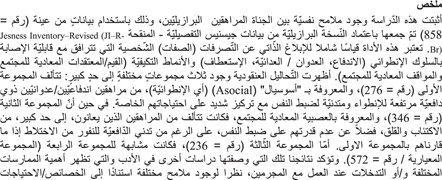Published online by Cambridge University Press: 12 March 2018
The present study verified the existence of psychological profiles among Brazilian adolescent offenders, using data from a sample (n=858) collected with the Brazilian version of the Revised Jesness Inventory (JI-R-Br). This instrument is a comprehensive, self-report measure of personal dispositions (traits) that are associated with vulnerability to antisocial behavior (Impulsivity, Aggression/Hostility, Sensation Seeking) and adaptive patterns (Antisocial Values/Beliefs and Antisocial Attitudes). Cluster analyses showed three significantly distinct groups: group 1 (n=276), called Asocial, was comprised of impulsive/aggressive adolescents with high antisocial motivation, low self-control and very focused on their own needs. Group 2 (n=346), called Neurotic Antisocial, was comprised of adolescents with high rates of depression and anxiety, as well as low self-control, but with less antisocial motivation when compared with group 1. Group 3 (n=236) was similar to group 4 (normative group; n=572). Our results corroborate those described by other studies in the literature. They show the importance of different practices and/or interventions when working with offenders, given that there are different profiles based on different psychological characteristics/needs for this population.
Este estudio verificó la existencia de perfiles psicológicos entre los delincuentes adolescentes brasileños, utilizando datos de una muestra (n=858) recopilada con el uso de la versión brasileña del Jesness Inventory-Revised (JI-R-Br). Este instrumento es una medida exhaustiva y autoinforme de las disposiciones personales (Rasgos) que están asociadas con la vulnerabilidad al comportamiento antisocial (Impulsividad, Agresión / Hostilidad, Búsqueda de Sensación) y patrones adaptativos (Valores Antisociales / Creencias y Actitudes Antisociales). Los análisis de conglomerados mostraron tres grupos significativamente distintos: el grupo 1 (n=276), llamado Asocial, estaba compuesto por adolescentes impulsivos / agresivos con alta motivación antisocial, bajo autocontrol y muy enfocados en sus propias necesidades. El grupo 2 (n=346), llamado Neurotico Antisocial, estaba compuesto por adolescentes con altas tasas de depresión y ansiedad, así como bajo autocontrol, pero con menor motivación antisocial en comparación con el Grupo 1. El grupo 3 (n=236) fue similar al grupo 4 (grupo normativo/n=572). Nuestros resultados corroboran los descritos por otros estudios en la literatura y muestran la importancia de diferentes prácticas y/o intervenciones cuando se trabaja con delincuentes, dado que existen diferentes perfiles basados en diferentes características/necesidades psicológicas para esta población.
Cette étude a mis en évidence l’existence de profils psychologiques parmi les adolescents délinquants brésiliens, grace aux données d’un échantillon (n=858) recueilli en utilisant la version brésilienne du Jesness Inventory-Revised (JI-R-Br). Cet instrument est une mesure complète et autodéclarée des dispositions personnelles (traits) associées à la vulnérabilité au comportement antisocial (impulsivité, agressivité/hostilité, recherche de sensations) et aux modèles adaptatifs (valeurs antisociales/croyances et attitudes antisociales). Les analyses ont montré trois groupes significativement distincts: le groupe 1 (n=276), appelé Asocial, est composé d’adolescents impulsifs/agressifs avec une motivation antisociale élevée, une faible maîtrise de soi et très concentrés sur leurs propres besoins. Le groupe 2 (n=346), appelé Neurotic Antisocial, est composé d’adolescents avec des taux élevés de dépression et d’anxiété, ainsi qu’un faible contrôle de soi, mais avec moins de motivation antisociale que le groupe 1. Le groupe 3 (n=236) est similaire au groupe 4, le groupe normatif (n=572). Nos résultats corroborent ceux décrits par d’autres études dans la littérature et montrent l’importance de différentes pratiques et/ou interventions dans le travail avec les délinquants, étant donné qu’il existe différents profils basés sur différentes caractéristiques psychologiques/besoins pour cette population.
本研究使用巴西版本的JesnessInventory-Revised(JI-R-Br)收集的樣本數據(n=858)驗證了巴西青少年犯罪者心理概況的存在。這個工具是一個綜合的,自我報告的與反社會行為(衝動,侵略/敵意,感覺尋求)和適應模式(反社會價值觀/信仰和反社會態度)相關的個人傾向(特質)。聚類分析顯示三個顯著不同的群體:組1(n=276),稱為社會,是由衝動/侵略性青少年高反社會動機,低自我控制和誰是非常專注於自己的需要。第二組(n=346)被稱為神經反社會,其組成部分是高抑鬱和焦慮,低自我控制的青少年,但與第一組相比,反社會動機較少。第三組(236人)與第4組相似(規範組/n=572)。我們的研究結果證實了文獻中其他研究所描述的結果,並且顯示了與罪犯進行工作時不同的實踐和/或乾預措施的重要性,因為根據不同的心理特徵/需求,這個人群有不同的特徵。

